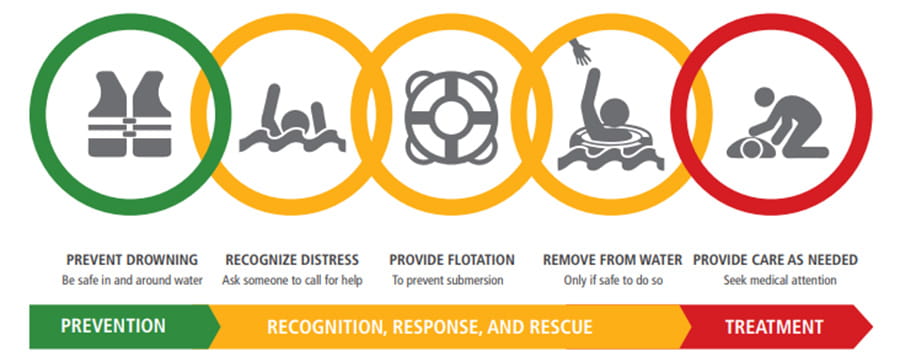
The Drowning Chain of Survival is a series of steps that attempts to reduce the mortality associated with drowning and attempted aquatic rescue. A brainchild of the International Life Saving Federation, the Drowning Chain of Survival was developed to assist in education on preventing drowning and how to react when an incident occurs.
This unique and universal diagram comprises five links that guide the important lifesaving steps for both bystanders and trained rescuers. The steps of the chain are: Prevent drowning, Recognise distress, Provide flotation, Remove from water, and Provide care as needed.
PREVENT DROWNING – Be safe in and around the water
Most drownings are preventable and can be avoided by employing multiple ‘layers of protection’, such as wearing a lifejacket on watercraft, swimming in safe areas where there are lifeguards, learning swimming and water safety skills, supervising children around water, and fencing off pools, spas and other aquatic locations.
To be effective, drowning prevention actions must be used by any individuals in, on or around water, as well as those who supervise or care for others where there is water around.
RECOGNISE DISTRESS – Call for help
Being able to recognise a person in distress in the water is a vital step in enacting a rescue. Someone who is struggling generally cannot call or wave for help. Some recognisable elements of a person at high risk of drowning include:
- a near vertical body position
- ineffective arm or leg movements e.g. pedalling or kicking
- little or no forward progress in the water
Identifying someone in distress quickly is a key element in the drowning response chain. As soon as an early drowning victim is suspected, call for help and ask someone to alert a lifeguard (if available) or call emergency services. Keep a constant watch on where the victim is in the water.
PROVIDE FLOTATION – to prevent submersion
The next step, after calling for help, is to interrupt the drowning process by providing a flotation aid to the victim. Most rescuers tend to focus on getting the victim out of the water even if it is unsafe for the rescuer.
Purpose-designed flotation devices are not always available at the scene of a drowning incident. Provide whatever buoyancy aid you can by improvising with items on hand, e.g. plastic bottles or containers, bodyboards or surfboards, driftwood, a football etc.
Many bystanders unfortunately end up as drowning victims themselves while attempting to rescue others, so it is safest for rescuers to remain out of the water to reduce this risk. The safest course of action is to throw or drop the buoyancy aid to the victim without entering the water.
REMOVE FROM WATER – Only if safe to do so
Again, safety of the rescuer is paramount in this step. Attempt to remove the victim without fully entering the water. Strategies include giving directions to the closest and safest place to get out or performing a reach or throw rescue with equipment. It is not recommended that an untrained person enter the water to rescue someone. If there are no other options and it is safe to enter the water, a rescuer should do so with a source of flotation to assist the victim.
PROVIDE CARE AS NEEDED – Seek medical attention
As soon as the victim is removed from the water, rescuers must assess the severity of the drowning so immediate care can be provided.
If the person is not breathing, commence CPR immediately and consider the use of oxygen and a defibrillator as soon as possible if available.
If the person is breathing, stay with them until help arrives. Seek medical attention if any symptoms are present, and for all victims who require resuscitation.